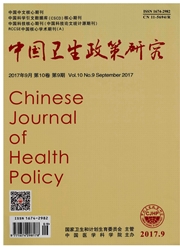

 中文摘要:
中文摘要:
目的:分析基本药物制度对基层医疗机构收入结构的影响。方法:对山西省实施基本药物制度的58家乡镇卫生院的收入状况与结构变化趋势进行分析。结果:随着政府对基层医疗机构投入的增加,基本药物制度基本实现全覆盖,基本药物收入占药品收入比重从2009年的20.45%上升到2013年97.03%,药品收入占总收入的比重下降了18.4%;与此同时,财政补助收入占总收入的比重从2009年的25.77%上升到2013年的54.16%,但业务收入占总收入比重总体呈下降趋势。结论:基本药物制度需要政府财政的大力支持,在进一步完善基层基本药物清单和基层财政补助政策的同时,完善医生薪酬和激励机制并改革不合理的医生劳务定价和补偿机制。
 英文摘要:
英文摘要:
Objective : To analyze the effects of essential medicine system on revenue structures at primary med- ical institutions. Methods:Data on revenue status and structures from 58 township health centers in Shanxi Province was collected to analyze changes and trends. Results: Along with growing government investments in primary medical institutions, the essential medicine system has fundamentally realized full coverage. The percentage of essential medi- cine revenue to pharmaceutical revenue rose from 20.45% in 2009 to 97.03% in 2013, though the percentage of pharmaceutical revenue to total revenue dropped by 18.43%. The percentage of fiscal subsidy revenue in total reve- nue rose from 25.77% in 2009 to 54. 16% in 2013, though the percentage of business revenue to total revenue dropped in general. Conclusions: The essential medicine system requires the government's financial support. Essen- tial medicine lists and primary financial aid policies should be further improved; doctor reimbursement and incentive mechanisms should be improved as well and unreasonable doctor service pricing and reimbursement mechanisms should be reformed.
 同期刊论文项目
同期刊论文项目
 同项目期刊论文
同项目期刊论文
 期刊信息
期刊信息
